Nikon D90 Review
Nikon D90 Introduction
The Nikon D90 is the first DSLR ever to shoot video. In addition to this new capability, the D90 is a full-featured DSLR with a 12 megapixels sensor, ISO 100-6400 sensitivities, 4.5 FPS continuous shooting, 11-point auto-focus with 3D tracking and a 3" high-resolution LCD.
The headline capability is that this DSLR shoots 1280x720 resolution video at 24 FPS, which corresponds to 720p HDTV. This produces 16:9 wide-screen aspect video with optional mono sound from an internal microphone.
Among Nikon's cropped-sensor DSLRs, the D90 represents the mid-range, between the entry-level D60 and the high-end D300. Feature-wise, the D90 is closer to the D300 than the D60, making it an interesting value among Nikon DSLRs.
This review describes and analyzes the D90's features, ergonomics, usability, image quality, performance and photographic controls. Important photographic features:
- 12 Megapixels image sensor, 1.5X crop-factor.
- Nikon F-mount with full Auto-focus support.
- Automatic and selectable ISO from 100-6400.
- 1/4000s to 30s shutter-speeds, plus bulb mode.
- Automatic, preset, kelvin and custom white-balance, all fine-tunable in 13-steps on 2 axes.
- Matrix center-weighed and spot metering.
- Standard PASM full manual controls.
- Exposure compensation: -5..+5 EV in 1/2 or 1/3 steps.
- Bracketing: 3 frames, 1/2..2 EV steps in terms of AE, Flash, both, White-Balance and Adaptive Lighting.
- Single, continuous, automatic and manual focus.
- 11-point auto-focus system with 3D tracking.
- Automatic, manual or dynamic focus-point selection.
- Single shot, continuous drive up to 4.5 FPS, live-view, customizable self-timer, remote and delayed remote.
- Standard flash modes: normal, redeye, slow, slow with redeye and rear-curtain sync.
- Built-in flash and hot-shoe.
- 96% coverage viewfinder with 0.94X magnification.
- 3” LCD 920K Pixels.
- Depth-of-field preview.
- Optional viewfinder grid.
- Hardware dust-reduction.
- Auto-ISO with selectable maximum sensitivity and minimum shutter-speed.
- Dual control wheels.
- Customizable Auto-Exposure-Lock button.
- Adjustable sharpness, contrast, brightness, saturation and hue.
- Illuminated top status panel.
- Secure Digital High Capacity (SDHC) memory.
- Lithium-ion battery.
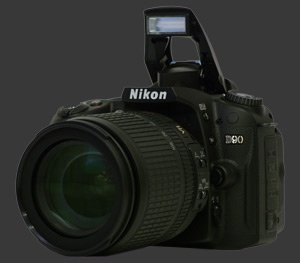
Nikon D90 Suitability - What is it good for?
Like all DSLR cameras, the Nikon D90 is suitable for every type of photographic subject. At 12 megapixels, the D90 has enough resolution for large prints and its 4.5 FPS drive is fast enough action photography. ISO sensitivities up to 6400 are also great for low-light. Add an 11-point auto-focus system with 3D tracking and you have a very capable action camera. The versatility of the Nikon D90 is further ensured by its compatibility with Nikon lenses and compatibility with Nikon's creative lighting system.
For specific photographic subjects, lens versatility is quite important. The Nikon lens lineup covers a wide variety of focal-lengths from the ultra-wide to the super telephoto. Most third-party manufacturers also produce lenses in Nikon mounts. Nikon image stabilization is provided by VR (Vibration Reduction) lenses which are available in some ranges of focal-lengths.
The Nikon D90 is a mid-size DSLR with durable build quality without being bulky. The lack of weather-seals means it cannot handle harsh environments, like most cameras in its price-range. Although 4.5 FPS is fast, there are now faster DSLR cameras which would be even more helpful for critical action shooting.
As the first DSLR to record movies, the Nikon D90 is still primarily a still image camera. Its body design and interface does not make compromises for this new feature. Instead, movie-recording is tacked on as an additional live-view feature. This makes the D90 suitable for occasionally recording short video-clips, but not suitable to replace a digital camcorder.
Nikon D90 Capability - What can it do?
As noted earlier, this DSLR has everything expected from a DSLR. Main features include a 12 megapixels sensor with sensitivities from 100 to 6400, built-in dust-reduction, 4.5 FPS continuous drive, an 11-point auto focus system, live-view and HDTV 720p movie-mode.
The Nikon D90's power-switch has 3 positions: Off, On and illuminate. The illuminate position is used to light up the top LCD or an option can be set to permanently illuminate it instead. The other two positions are self-explanatory but note that, even when the camera is off, the D90 shows how many images can still fit into the memory card at the currently set quality, resolution and file-format. This is fantastic because you can tell if you have a card inserted without effort. Wish it did this too for battery-capacity.
The shutter-release on this DSLR is a standard two-stage release with a very soft halfway point. By default, pressing the shutter-release halfway locks focus and exposure. Exposure locking can be disabled. There is a combined AE-L/AF-L button which can be set to one of 6 functions, including locking exposure and focus, only exposure, only focus, holding exposure across shots, locking flash power and triggering auto focus. AE-L appears in the viewfinder whenever exposure is locked, regardless of the mechanism. This allows to confirm which behavior is active.
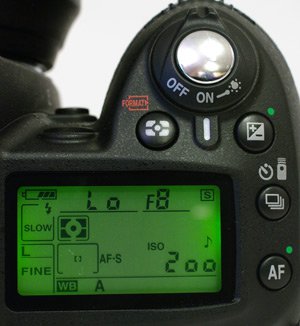
Metering is controlled using a top-mounted button just near the shutter-release. It selects between Matrix, Center-weighed and Spot metering. Center-weighed metering is controllable to use 6, 8 or 10mm center radius.
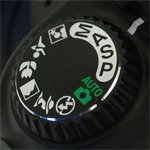 Exposure modes on the Nikon D90 are controlled by a traditional mode-dial. The four ubiquitous modes are available. These are: program (P), shutter-priority (S), aperture-priority (A) and full manual (M) mode. Also on the mode-dial is a fully automatic mode which puts the built-flash on automatic, disables white-balance and exposure-compensation plus produces vivid colors. This last detail alone should turn off anyone from using this Auto mode for any image which should resemble reality. There are also 6 scene-modes: night portrait, action, macro, landscape, portrait and no flash. These modes affect exposure parameters and color rendition.
Exposure modes on the Nikon D90 are controlled by a traditional mode-dial. The four ubiquitous modes are available. These are: program (P), shutter-priority (S), aperture-priority (A) and full manual (M) mode. Also on the mode-dial is a fully automatic mode which puts the built-flash on automatic, disables white-balance and exposure-compensation plus produces vivid colors. This last detail alone should turn off anyone from using this Auto mode for any image which should resemble reality. There are also 6 scene-modes: night portrait, action, macro, landscape, portrait and no flash. These modes affect exposure parameters and color rendition.
In Manual mode, the shutter-speed selection includes a Bulb mode that keeps the shutter open as long as the shutter-release is pressed. In Program mode, the main control-wheel shift shutter-speed and aperture simultaneously to maintain a correct exposure. Having two control wheel makes it easy to control exposure parameters. One wheel controls aperture and another controls shutter-speed in most cases. When only one parameter is directly selectable, the potentially unused control wheel can be used to control ISO (always in 1/3 EV steps) or EC (in 1/3 or 1/2 EV steps). ISO can also be controlled using the ISO button in combination with the rear control wheel. In Manual mode, this is the only way to set the sensitivity.
Drive-mode and bracketing are independently set. This allows to combine use of the self-timer with bracketing and to determine if bracketing is continuous or not. The bracketing button also selects the number of frames (2 or 3) and the exposure increment (1/3..2 EV).
Auto focus. is activated separately from its enabled or disabled state. A switch choose between AF and MF, while a button selects between automatic, single and continuous auto focus. Needless to say, the state of the AF/MF switch overrides the selected focus-mode.

The Nikon D90 has detailed control over white-balance. The nine settings include automatic white-balance, preset white-balanceIncandescent, Fluorescent, Sunlight, Flash, Cloudy and Shade., manual white-balance and color-temperature. All these can be fine-tuned in 13-steps from blue to amber and magenta to green. Curiously, even Kelvin white-balance can be adjusted, meaning that the chosen color temperature is not necessarily accurate. Manual white-balance is storable in one of 4 memory slots with a reference thumbnail to help remember which one is which.
Exposure compensation can be adjusted in 1/2 or 1/3 stop increments using the EC button and the command dial. The range of exposure compensation is -5 to +5. The D90 has a bracketing feature as well. It can take 2 or 3 frames set apart by Auto-Exposure (AE), Flash, AE & Flash, White-Balance and Adaptive-Lighting. This DSLR supports has numerous drive modes: single, low-speed continuous, 4.5 FPS high-speed continuous, self-timer, remote and delayed-remote. The self-timer can be set to 2s, 5s, 10s and 20s delay and between 1 and 9 shots. The self-timer is not automatically reset after each use.
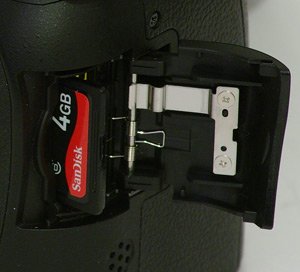
The Nikon D90 supports both JPEG and RAW images. RAW images are storing in Nikon's own NEF format. JPEG format images are available in 3 quality levels. A RAW+JPEG mode stores both a RAW and a JPEG image of any quality during each shot. The camera has in-camera RAW development capability with white-balance and exposure preview. Too bad there is no histogram display when adjusting exposure so that we know when clipping occurs.
The sensor filter is mounted on a moving plate which serves to shake off dust, reducing its accumulation. While we have not measured its efficiency, these systems are never 100% effective and only remove the lightest of dust-particles. Any significantly stuck particle requires manual cleaning.
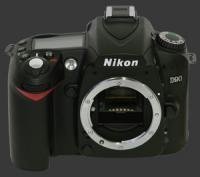 |
Please Support Neocamera
All information on Neocamera is provided free of charge yet running this website is a huge endeavor. Purchases made via affiliate links found throughout the site help keep it running and up-to-date. There is no additional cost to you, so please consider buying via these links to our affilates:
If you found any information on this site valuable and did not purchase via our affiliate links, please considering donating via PayPal:
Any amount will be greatly appreaciated. Thank you for your support!
Nikon D90 Highlights

Sensor-Size: 24 x 16mm

Actual size when viewed at 100 DPI
| 12 Megapixels DSLR | ISO 100-6400 |
| Nikon F Mount 1.5X FLM | Shutter 1/4000-30s |
| 96% Coverage Large Viewfinder | Full manual controls, including Manual Focus |
| Built-in Dust Reduction | Custom white-balance with 2 axis fine-tuning |
| 4.5 FPS Drive, 100 Images | Spot-Metering |
| 1280x720 @ 24 FPS Video Recording | Hot-Shoe |
| 3" LCD 920K Pixels | Lithium-Ion Battery |
| Secure Digital High Capacity |
Movie Mode
Even without movie-recording mode, the D90 is both a competent DSLR and a great value given its ergonomics and feature set. Without further ado, video capability is the most distinguishing feature of this DSLR. Among so many digital SLR cameras, being the first of still only two is an excellent proposition for the Nikon D90. Plus, this one is roughly 1/3 of the price of the Canon 5D Mark II, the other video-capable DSLR.
The Nikon D90 is capable of shooting HD movies with a resolution of 1280x720 at 24 FPS. This is known as the 720p HDTV resolution. This is a wide screen resolution with a 16:9 aspect ratio, compared to the 3:2 aspect of still images from the D90. This is apparently when using the live-view mode to which movie-recording is attached. Contrarily to fixed-lens digital cameras, the D90 does not have a dedicated movie-mode. Instead, live-view mode is started and ether the shutter-release is pressed for still images or the OK button for movie-recording. The result is that the D90 does not know which aspect ratio to show until the OK button is pressed. When movie-recording starts, the areas outside the recording area are masked, possibly clipping a tightly-framed subject.
Being first with a feature means that there is no basis for comparison among DSLRs and that any limitation is just part of the game. There are 4 main limitations to movie-recording with the D90:
- Auto focus. is disabled, even contrast-detect. Manual focus though is possible.
- Exposure is automatic aside from exposure compensation. Aperture, shutter-speed and ISO are under control of the camera.
- HD clips are limited to 5 minutes or 2 GB file length, whichever comes first.
- Sound is either completely off or mono from a built-in microphone.
Updates
2024.04.03

Fujifilm X-T5 Review
Newest Fujifilm flagship boasting a 40 MP APS-C sensor, 5-axis IBIS with 7-stop efficiency, 15 FPS continuous drive, 6.2K Video capture, dual control-dials and dual SDXC UHS-II slots in a sturdy weatherproof and freezeproof body.
2023.11.20

Best Digital Cameras of 2023
Find out which are the Best Digital Cameras of 2023. All the new Mirrorless Digital Cameras from entry-level to high-end professional.
2023.07.10

Fujifilm X-H2 Review
40 Megapixels APS-C Hybrid Mirrorless Digital Camera with 7-stop IBIS. Fastest shutter ever and 8K video capture. Large builtin EVF with 0.8X magnification and 5.8 MP, plus an Eye-Start Sensor. Packed with features and large number of controls in a weatherproof and freezeproof body.
2023.05.07

Sony FE 20-70mm F/4G Review
Review of the unique Sony FE 20-70mm F/4G lens. The optical zoom of this lens spans ultra-wide-angle and medium focal-length coverage, making it one of the most versatile Full-Frame lenses on the market.
2023.01.15

Huion Inspiroy Dial 2 Review
Review of the Huion Inspiroy Dial 2 tablet, a medium sized drawing surface with dual dials and customizable buttons. Connects via USB-C or Bluetooth 5.0 with Windows, Linux and Android support.
2022.12.08

How to Pack for a Photo Trip
Find out how to pack for a travel photography trip, carry your gear safely while meeting airline regulations.
2022.11.13

Best Digital Cameras of 2022
The best digital cameras of 2022. A short list of the most outstanding models in their respective categories. Choose one for yourself or as a gift.
2022.09.21

Pentax DA* 60-250mm F/4 SDM Review
Review of the Pentax DA* 60-250mm F/4 SDM, the constant-aperture telephoto zoom with the highest zoom-ratio on the market.
2022.09.20

Pentax DA* 50-135mm F/2.8 SDM Review
Review of the Pentax DA* 50-135mm F/2.8 SDM, the lightest professional telephoto zoom native to the K-mount.
2022.09.10

Pentax DA* 11-18mm F/2.8 DC AW Review
Review of the Pentax DA* 11-18mm F/2.8 DC AW, the widest professional ultra-wide zoom native to the K-mount.
2021.11.24

50 Gifts Under $50 For Photographers in 2021
50 Gifts photographers will love. All for under $50 USD. 2021 Edition.
2021.11.17

Best Digital Cameras for 2021
Neocamera shows which are the very best Digital Cameras for 2021 in every category: Mirrorless, DSLR, Premium Compact, Ultra-Zoom and Rugged.











